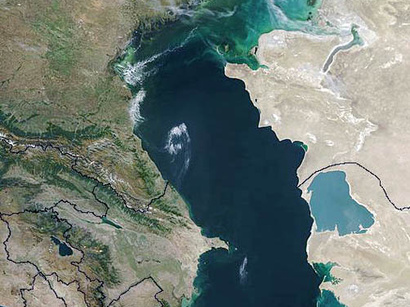Caspian sturgeon population declining to critical level

By Nigar Orujova
Recent studies show that the number of sturgeons in the Caspian Sea has decreased to a critical level, a leading expert said.
Ilham Alekperov, Head of the Zoology Institute of the Azerbaijan National Academy of Sciences, said the main reason for the decline of the sturgeons in the Caspian Sea is primarily a large-scale illegal fishing in the rivers and the sea. “Sturgeon fishing throughout the year led to a decrease in their population.”
Conducting seismic exploration in the Caspian Sea has also had an impact on the reduction of the sturgeons’ number, Alekperov added.
The comb jelly, made its way from the Black Sea to the Caspian Sea using the ballast water of ships, and now is growing rapidly, the director said.
Joint research with American scientists has shown that the comb jelly has badly harmed plankton of the Caspian Sea. Mnemiopsis used Caspian plankton as food and rapidly multiplied.
Progress of Mnemiopsis has a negative impact on the food resources of most fish, including sturgeon.
The director of the Institute noted that the Caspian Sea is polluted by not only dirty waters of Volga and Kura rivers, but also industrial and chemical waste, various chemical wastes from the oil production in the sea.
Integrated pollution of the Caspian Sea for many years is the main reason for the decrease of the sturgeons’ number, he added.
Alekperov said that conventional seismic exploration work carried out using pneumatic devices, which are not listed as a polluting factor, also lead to the decrease of the sturgeons. Blasts of air compressed to 150 atmospheres destroy plankton in a large area.
The institute investigated the effect of seismic exploration on the fauna of the Caspian Sea, and it was found that during these studies, that last from two to three months, a dead zone formed in the water of this plankton. Invertebrates - rotifers and crustaceans - were completely dead, some mollusks also died.
The negative results are especially noticeable during seismic exploration in shallow water, the scientist noted.
"Biomonitoring of seismic survey of oil companies "ELF", "Adip", "JAOC" shows that the implementation of such works at a depth of less than 20 meters causes destruction of zoobenthos, which is food for fish," he said.
These cases explain the critical condition of sturgeons and confirms the need to reduce anthropogenic stress, primarily to prevent illegal fishing, Alekperov stressed.
The Caspian Sea is a home to 80-85 percent of the world sturgeon, now witnessing a sharp decrease of these fish species.
Some 90 percent of the popular black and red caviar sold all over the world comes from this region. The Caspian states banned any industrial or commercial sturgeon fishing in the sea in 2014.
Moreover, the Caspian Sea with its rich natural resources is also home to about 141 other fish species. However, this natural wonder is struggling with different problems including pollution.
There has been a tenfold decrease in the number of sprats and sturgeons in the Caspian Sea over the past years.
Five coastal states, Azerbaijan, Kazakhstan, Russia, Turkmenistan and Iran, signed a framework convention on the protection of the marine environment of the Caspian Sea in November 2003.
The Zoology Institute of the Azerbaijan National Academy of Sciences has recently developed a concept for industrial breeding of sturgeon by innovative method.
Creation of farm with the production capacity of 45 tons of sturgeon per year is suggested as the first pilot project in the prepared concept.
--
Nigar Orujova is AzerNews’s staff journalist, follow her on Twitter: @o_nigar
Follow us on Twitter @AzerNewsAz
Here we are to serve you with news right now. It does not cost much, but worth your attention.
Choose to support open, independent, quality journalism and subscribe on a monthly basis.
By subscribing to our online newspaper, you can have full digital access to all news, analysis, and much more.
You can also follow AzerNEWS on Twitter @AzerNewsAz or Facebook @AzerNewsNewspaper
Thank you!
